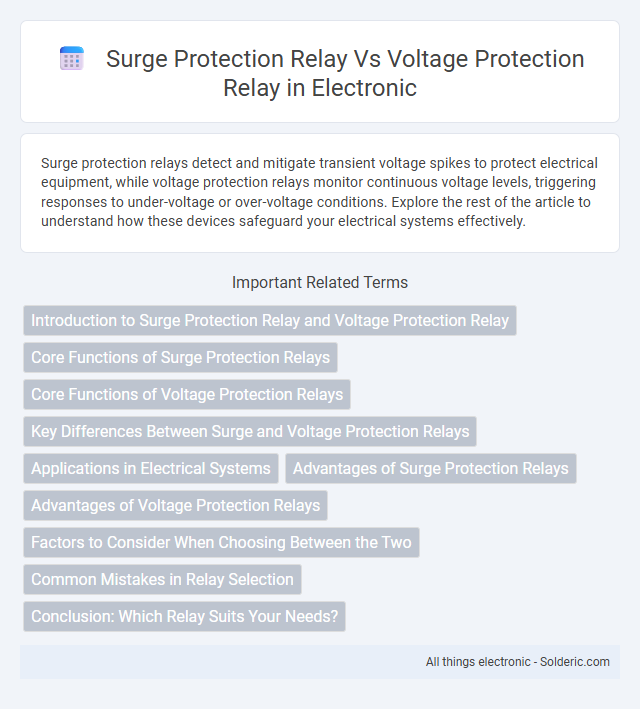Surge protection relays detect and mitigate transient voltage spikes to protect electrical equipment, while voltage protection relays monitor continuous voltage levels, triggering responses to under-voltage or over-voltage conditions. Explore the rest of the article to understand how these devices safeguard your electrical systems effectively.
Comparison Table
| Feature | Surge Protection Relay | Voltage Protection Relay |
|---|---|---|
| Function | Protects against voltage spikes and transient surges | Monitors and protects against abnormal voltage levels (overvoltage/undervoltage) |
| Protection Type | Transient surge suppression | Continuous voltage monitoring |
| Common Applications | Lightning protection, switching surge mitigation | Power system stability, equipment voltage regulation |
| Response Time | Rapid, milliseconds to microseconds | Typically milliseconds to seconds |
| Key Components | Metal oxide varistors (MOV), gas discharge tubes | Voltage sensors, microprocessor control |
| Output | Trip signal or diversion of surge energy | Trip signal or alarm on voltage deviation |
| Cost | Moderate | Moderate to high |
| Typical Voltage Range | High-voltage transient events | Wide voltage range monitoring |
Introduction to Surge Protection Relay and Voltage Protection Relay
Surge protection relays detect and mitigate transient voltage spikes caused by lightning or switching operations, safeguarding electrical equipment from damage. Voltage protection relays monitor voltage levels to prevent equipment malfunction by isolating circuits during under-voltage or over-voltage conditions. Both relays play crucial roles in maintaining power system stability and protecting assets from electrical faults.
Core Functions of Surge Protection Relays
Surge protection relays primarily detect and mitigate transient voltage spikes caused by lightning strikes or switching operations, safeguarding electrical equipment from damage. They monitor surge currents and trigger protective mechanisms to divert or absorb excess energy, preventing insulation breakdown and equipment failure. Unlike voltage protection relays, which focus on maintaining stable voltage levels, surge protection relays specialize in handling high-energy, short-duration surges for enhanced system reliability.
Core Functions of Voltage Protection Relays
Voltage protection relays primarily monitor voltage levels in electrical systems to detect overvoltage, undervoltage, and phase imbalances, ensuring stable power supply and preventing equipment damage. These relays trip or trigger alarms when voltage deviations exceed preset thresholds, maintaining system reliability and safety. Unlike surge protection relays that guard against transient voltage spikes, voltage protection relays focus on sustained voltage abnormalities for long-term operational stability.
Key Differences Between Surge and Voltage Protection Relays
Surge protection relays primarily safeguard electrical equipment from transient voltage spikes caused by lightning or switching operations by detecting and isolating surges, whereas voltage protection relays continuously monitor and control the system voltage to prevent sustained overvoltage or undervoltage conditions. Surge relays respond to sudden, short-duration high-voltage impulses, while voltage protection relays maintain the stability of power supply within predefined voltage limits. The key difference lies in their operational focus: surge protection relays handle instantaneous surges, and voltage protection relays manage steady-state voltage deviations to ensure system reliability.
Applications in Electrical Systems
Surge protection relays are essential in electrical systems for safeguarding sensitive equipment from transient voltage spikes caused by lightning strikes or switching operations. Voltage protection relays continuously monitor voltage levels and disconnect the load during abnormal conditions such as overvoltage or undervoltage to prevent damage to connected devices. Both relays enhance system reliability by minimizing outages and equipment failures in industrial, commercial, and residential power networks.
Advantages of Surge Protection Relays
Surge protection relays offer superior defense against transient voltage spikes, safeguarding sensitive electrical equipment from damage caused by lightning strikes or switching surges. They provide faster response times and higher sensitivity compared to voltage protection relays, ensuring better reliability and longer equipment lifespan. Your electrical system benefits from reduced downtime and maintenance costs due to enhanced surge mitigation capabilities.
Advantages of Voltage Protection Relays
Voltage protection relays offer precise monitoring and control of voltage levels, preventing damage from overvoltage and undervoltage conditions, which enhances the reliability of electrical systems. These relays provide faster response times and greater sensitivity compared to surge protection relays, ensuring more effective protection of critical equipment. Your electrical system benefits from improved stability and reduced downtime with the use of voltage protection relays.
Factors to Consider When Choosing Between the Two
When choosing between a surge protection relay and a voltage protection relay, consider the specific electrical risks present in your system. Surge protection relays are designed to detect and mitigate sudden voltage spikes caused by lightning or switching operations, safeguarding sensitive equipment. Voltage protection relays monitor and control voltage levels to prevent damage from sustained overvoltage or undervoltage conditions, ensuring the stability and longevity of your electrical assets.
Common Mistakes in Relay Selection
Choosing between surge protection relays and voltage protection relays often leads to common mistakes such as confusing their primary functions; surge protection relays safeguard against transient overvoltages caused by lightning or switching, while voltage protection relays monitor sustained voltage deviations. Many users incorrectly select surge protection relays for voltage regulation tasks, which can result in inadequate system protection and potential equipment damage. Ensuring your relay choice matches the specific type of voltage anomaly in your electrical system is critical for reliable and effective protection.
Conclusion: Which Relay Suits Your Needs?
Surge protection relays are designed to detect and isolate transient voltage spikes caused by lightning or switching events, ensuring sensitive equipment remains unharmed. Voltage protection relays monitor continuous voltage levels, preventing damage due to overvoltage or undervoltage conditions in electrical systems. Choosing the right relay depends on whether your primary concern is shielding against sudden surges or maintaining stable operational voltage within specified limits.
Surge protection relay vs voltage protection relay Infographic

 solderic.com
solderic.com